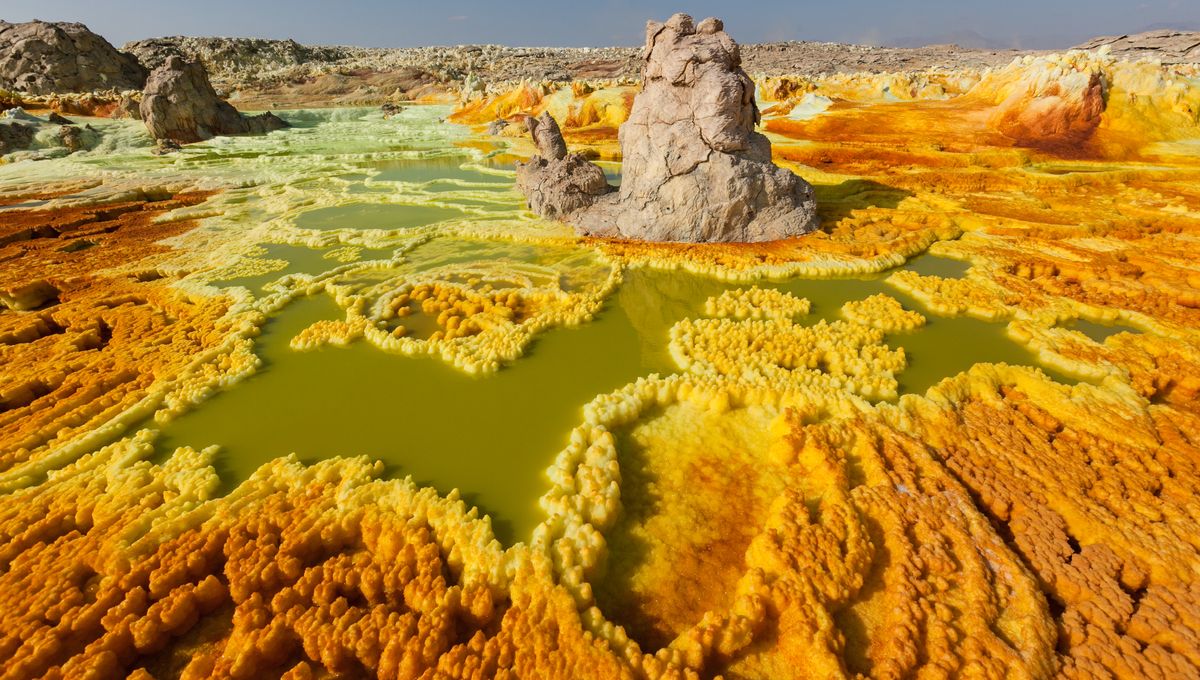
This article first appeared in Issue 11 of our free digital magazine CURIOUS.
Searing hot water. Sulfurous springs. Pools of caustic acid and plumes of scorching steam. Sounds hectic, right? Nonetheless, the Danakil Depression in northern Ethiopia is a geological hit with curious sightseers. Its blue-burning lava and bright yellow springs might be a psychedelic assault on the eyes, but they’re the spectacular manifestation of continental rifting.
The Earth’s crust is not a uniform thickness across the planet, and in places like the Danakil Depression, the effects of continental rifting can be seen in vivid technicolor. Here, tectonic plates are pulling apart, separating formations like the Danakil Alps and Ethiopian Plateau that were once neighbors.
The hot, colorful, and treacherous terrain has earned the region the nickname “Gateway To Hell,” but it’s been utilized by humans mining for salt by hand for centuries, and has since become a popular tourist destination.
Subscribe to our newsletter and get every issue of CURIOUS delivered to your inbox free each month.
According to NASA’s Earth Observatory, the ever-sinking landscape at the Danakil Depression means it will one day fill with water to form a great lake or possibly even a new ocean – but for now, more formidable things bubble on its surface. The Danakil Depression is home to Gada Ale, a volcano that sits at around 287 meters (942 feet) and joins the Erta Ale chain of volcanoes. It’s a stratovolcano, made up of layers of lava and ash inside which a vast crater lake of scalding liquids and gases simmers.
The hot and inhospitable environment is a cacophony of sights and smells, the most alluring of which seem to be found at the Dallol sulfur springs. Sitting at the base of the Dallol Volcano, the crusty salt flat is pockmarked with springs and craters in near-neon hues of green, orange, and yellow.
The region’s wild coloration comes from the unique terrain that brings together seawater and volcanic minerals including sulfur, iron, and copper. Despite belching out combinations of chlorine and sulfur gas, researchers discovered back in 2017 that life can thrive in Dallol’s waters, though it is very small.
They found evidence of bacteria living in the waters that are classed as “polyextremophiles” for being able to tolerate the extremes of heat, salinity, and acidity all at once. But before you head out to get a look at their alien-like habitat, it’s worth considering this first-person account.
“The environment is very extreme,” Barbara Cavalazzi from the University of Bologna in Italy, who has been conducting expeditions in Danakil since 2013, told the BBC. “On average, the temperature over there around lunchtime can reach 48°C (118°F). One time we measured 55°C (131°F).”
Steamy.
CURIOUS magazine is a digital magazine from IFLScience featuring interviews, experts, deep dives, fun facts, news, book excerpts, and much more. Issue 14 is out now.
Source Link: The Alien Terrain Of The Danakil Depression